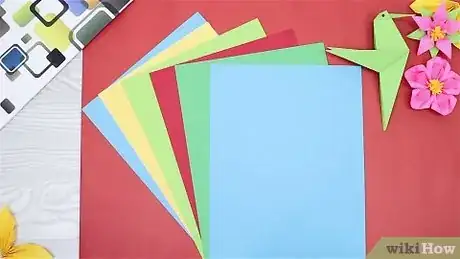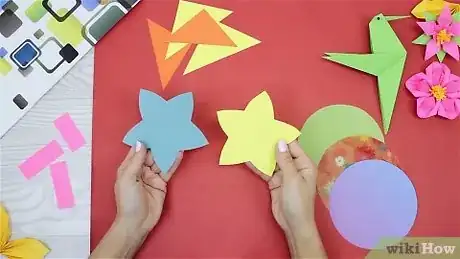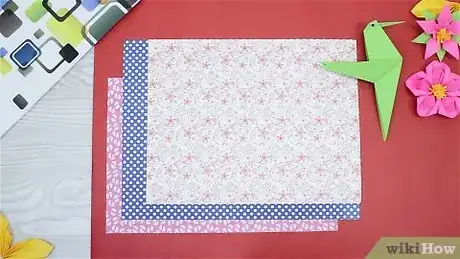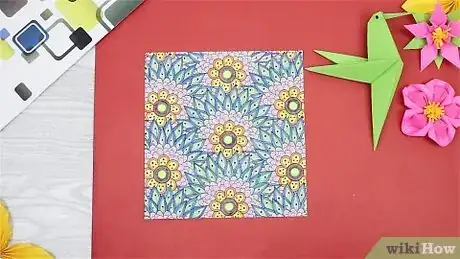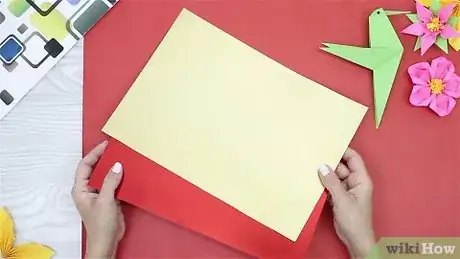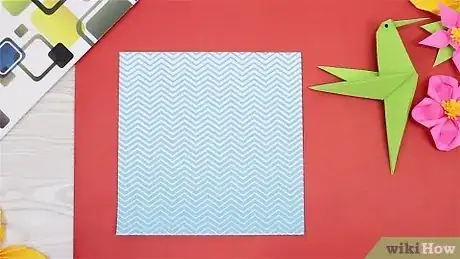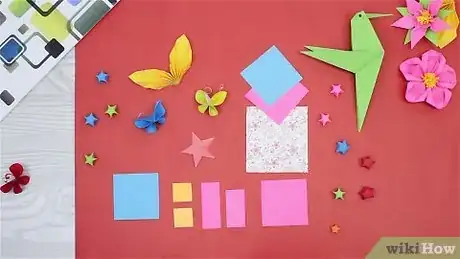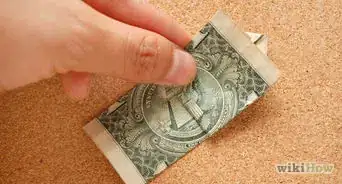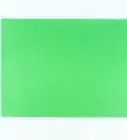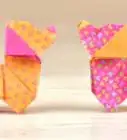This article was co-authored by wikiHow Staff. Our trained team of editors and researchers validate articles for accuracy and comprehensiveness. wikiHow's Content Management Team carefully monitors the work from our editorial staff to ensure that each article is backed by trusted research and meets our high quality standards.
The wikiHow Video Team also followed the article's instructions and verified that they work.
This article has been viewed 113,258 times.
Learn more...
Origami is a traditional Japanese art form that involves folding paper into elaborate shapes, such as flowers and animals. An art of great simplicity, origami requires no other tools than a sheet of paper and your own two hands. For this reason, it’s important to work with paper that folds well, retains its shape, and has the right aesthetic to suit the vision you have in mind for your design.
Steps
Finding the Right Paper for Your Project
-
1Think about the size of the design you wish to create. Before you get to folding, consider how large or small the design you’re trying to make needs to be. Complex, impressive pieces may benefit from added size, which means you should use a sheet of paper that is larger and can be folded more ways. On the other hand, smaller paper forces you to work meticulously, and results in stunning, delicate shapes.
- Origami paper can come cut as large as 30”x20”, and as small as a mere 1”x1” for challenging miniature pieces.
-
2Make use of color. Your origami doesn’t have to be made from dull white paper. Take color into account when deciding on a design. Origami paper can be found in a multitude of color combinations, with products like duo paper which has a different color on each side. Other papers feature brightly-colored patterns and embellishments, each presenting unique possibilities.[1]
- Different colors will suit different projects. For instance, an origami strawberry can be fashioned from red and green duo paper, while a lotus may look best in one tasteful pastel sheet.
Advertisement -
3Work with textured papers. For an interesting visual element, look into papers that have textures that make them stand out among conventional types. Certain types of washi, or traditional Japanese origami paper, are woven from plant fibers and are characterized by a soft, slightly wrinkled consistency. These papers can give completed projects an added degree of visual texture and appeal.[2]
- Other types of textured paper-like momigami (a leathery paper made from the bark of the mulberry tree) and foil paper highlight surface detail while also manipulating the way light hits the contours of the design.
-
4Choose an unusual shape. Not all origami paper comes in squares. See what sorts of new objects you can fold using circular or triangular paper, or any number of other unorthodox shapes. Working with alternative shapes requires you to view your project from a fresh perspective and changes the types of techniques you’re able to employ and designs you’re able to create.
- Some techniques may be altered drastically when using oddly shaped papers, as there may be more or fewer precise edges and corners to aid in folding.
Choosing a Traditional Paper
-
1Buy a standard pack of washi. Washi is a term that simply means “Japanese paper” and is usually used to describe the basic type of folding paper used to make origami shapes in Japan and overseas. Washi is made to fold easily and maintain its shape, and since it’s a no-frills type of paper, it will probably work best for standard usages and beginners learning the ropes of origami. Washi comes in a square, standardized size and can be purchased in most craft stores around the world.[3]
- Washi is the most common type of origami paper and will be the go-to choice for most projects.
-
2Use duo paper to add color layers. Named because of its coloration, duo paper is a basic paper type that features a different color on each side of the sheet. Choose duo paper when you’re folding shapes that benefit stylistically from a certain color scheme (such as red and green for a rose), or if your purpose is to make the design more intricate by incorporating different layers of color.
- Care must be taken to fold duo paper correctly, as misalignments will be made more visible by the contrast in color.
-
3Try chiyogami paper for traditional designs. Chiyogami is another conventional Japanese origami paper. In most cases, it is basic washi, only bearing classical Japanese artwork, prints, and patterns. Chiyogami paper is more elaborate in appearance than other varieties, and is an available option should you wish to learn traditional Japanese shapes and folding styles.
- There are many traditional origami papers bearing classic Japanese aesthetics. In addition to basic chiyogami, there is yuzen, a particular variation of chiyogami that features prints inspired by popular fabrics from ancient Japan; momigami, fashioned from mulberry bark and known for its leathery texture; and shinwazome, a thick, brilliantly adorned paper with embossed patterns that is often used for more extravagant projects.
-
4Add luster with foil paper. Lend a little shine to your art by picking up some foil paper, which has a standard folding paper on one side and a thin layer of metallic foil on the other. Foil origami paper is sure to catch the eye as your designs sparkle with a gold, silver, or ruby glint. The foil will also help preserve your folds, as the pliable metallic layer holds a crease that won’t spring back out of place.
- Another additional benefit of working with foil paper is that it allows the handler to fashion smooth curves in their designs that easily maintain their shape.
- It will be hard to hide mistakes made with foil paper, as the paper will remain crinkled even after it is smoothed out.[4]
Working with Other Paper Types
-
1Experiment with found paper. Paper is everywhere, and all of it could become beautiful origami in the right hands. Return the art to its ultimate simplicity by folding any sort of paper you come across, including newsprint, magazine pages, card stock, and wrapping paper. This way you’ll never run out of supplies, and your projects will take on an intriguing, homemade vibe.[5]
- Working with found paper reinforces the original spirit of origami, which is a form of art that can be practiced anywhere at any time with most any materials.
- Not all found paper types will fold with the same degree of success. Copy paper can be found anywhere, is sturdy and holds a crease well, but is too thick for more detailed designs, while newsprint and other similar materials is thin enough to allow for more complex folds but creases stubbornly, and is usually quite weak and therefore prone to tearing.
-
2Look for dazzling designs. Not all origami paper is limited to solid, conservative colors. Modern alternatives include wild patterns like chevron and animal prints such as leopard, tiger, and zebra. Choosing one of these eye-catching paper design will allow you to infuse a little contemporary flair.
- Because patterned papers are printed in a certain directional configuration, they may be best for simpler designs. In complex shapes, the print may run together and be disorienting to the eye.
-
3Try out different sizes. Unlike traditional washi, which is cut to a specific set of dimensions, many modern origami papers come in multiple sizes that give the handler much more control over the scale of the design. Some papers can be quite large, allowing for oversized, statuesque pieces, while smaller variants are used to produce elegant miniatures.[6]
- Vary the dimensions of the paper you use to have many different sizes of origami to put on display.
- You can also cut found paper to whatever specifications you prefer if the size of a premade paper won’t do.
-
4Make your own origami paper. Incorporate some of your own personality into your next origami project by designing your own paper. Take a standard piece of washi or duo paper (or another preferred kind if you’re an experienced folder) and decorate it by hand using freehand linework, vibrant colors of even personalized text excerpts. When you’re finished, you’ll have a one-of-a-kind piece of paper art to show off.[7]
- The number of ways you can design your own origami paper is limited only by the depth of your imagination.
- Try composing a note or holiday card to a loved one and giving it to them in the form of origami.
Community Q&A
-
QuestionCan we use cutting in origami?
 Community AnswerTraditional origami involves no cutting, taping, or gluing to obtain the finished piece.
Community AnswerTraditional origami involves no cutting, taping, or gluing to obtain the finished piece. -
QuestionCan I use plain, lined writing paper?
 Community AnswerYes you can, in some origami plain cardboard paper is better, but you can use lined paper.
Community AnswerYes you can, in some origami plain cardboard paper is better, but you can use lined paper. -
QuestionIs it okay to use construction paper for origami?
 Community AnswerYes, but be aware that more complicated origami will be more difficult because of the paper's thickness. Folding thick paper can be made easier by dampening it a bit with a spray bottle, but be careful not to get the paper soggy or it will tear.
Community AnswerYes, but be aware that more complicated origami will be more difficult because of the paper's thickness. Folding thick paper can be made easier by dampening it a bit with a spray bottle, but be careful not to get the paper soggy or it will tear.
References
- ↑ http://iml.jou.ufl.edu/projects/fall09/fung_n/paper.html
- ↑ http://www.stormthecastle.com/origami/guide-to-origami-paper.htm
- ↑ http://www.stormthecastle.com/origami/guide-to-origami-paper.htm
- ↑ http://iml.jou.ufl.edu/projects/fall09/fung_n/paper.html
- ↑ http://www.langorigami.com/article/paper
- ↑ http://www.stormthecastle.com/origami/guide-to-origami-paper.htm
- ↑ http://www.cutoutandkeep.net/projects/make-your-own-origami-paper
About This Article
For a traditional origami project, buy some washi origami paper or, for a cheaper version, cut printer paper into squares for a similar effect. Size is also important, so aim to start with a larger piece of paper if you’re making a more complex design. Next, choose a color that makes sense for what you want to represent. For example, grab some red and green paper if you’re constructing an origami strawberry. Alternatively, if you want to highlight surface details, use textured paper like the leathery momigami, which is made from the bark of the mulberry tree. For more guidance on how to choose paper for your origami project, read on!
